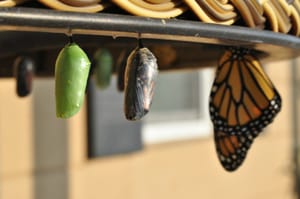Hindi summary:
अधिकांश वैज्ञानिक संचार अंग्रेजी में होता है, लेकिन अधिकांश दुनिया अंग्रेजी नहीं बोलती है। व्यापक भागीदारी को प्रोत्साहित करने और विविध आवाजों को ऊपर उठाने के लिए कई भाषाओं में विज्ञान का संचार करना महत्वपूर्ण है। इस लेख में, कनिका खन्ना बहुभाषी विज्ञान संचार के महत्व पर और इन प्रयासों में कोई कैसे संलग्न हो सकता है, उस पर चर्चा करती हैं।
In 2016, I sat ashamed in front of a bunch of kids when I couldn’t recall the word for “scientist” in my mother tongue, Hindi. I had volunteered to talk to them about my career as a scientist in the serene foothills of the Himalayas. Little did I realize that they didn't understand English. I fumbled and stumbled to find the right words to explain what I do as a scientist until a facilitator came along and translated my “Hinglish” (a hybrid of Hindi and English) for the students. Even though my first language is Hindi, my schooling in India made me more comfortable writing and conversing about science in English as it is considered the lingua franca of science. Most jobs also require fluency in English in India, where it is considered a passport to a better life.
"Even if you grew up speaking another language, when you stop speaking that language regularly, you start to lose your fluency,"
Jessica Vélez, Genetics Society of America
Six years later, I joined the “The Languages of Science” webinar from the comfort of my room. eLife organized the event as part of the eLife Community Ambassadors program. I immediately related to Jessica Vélez, the Membership, Engagement, and Early Career Programs Manager of the Genetics Society of America (GSA) Engagement Department, who remarked, “Even if you grew up speaking another language, when you stop speaking that language regularly, you start to lose your fluency.” At this moment, I was taken back to my 2016 school visit and realized that it is common to lose mastery of your native language if you don't converse in it regularly.
We started the webinar with a poll, which made us realize that all of us spoke a language other than English. Only about 15 percent of the world’s population speaks English and of those, only a quarter have English as their first language. Despite this, almost all scientific journals are published in English and the majority of science communication (like this piece written by me) happens in English.
Marah Wahbeh, a panelist and PhD candidate in human genetics at Johns Hopkins University School of Medicine, raised an important question: “Who is the science that we do targeted to? Is it gatekept to those who speak English?” We discussed the pros and cons of having one language for science communication. In terms of advantages, it is easier for scientists to communicate and collaborate if they speak a universal language for science, which currently is English. However, this excludes people who are unable to communicate in English from accessing and participating in science. This also reduces the visibility of researchers and their work who publish in a language other than English.
Did you know that PubMed allows you to search for articles in languages other than English? One simply has to go to “Advanced Filters” and select their languages of choice in the “Languages” tab.
What then can we do to promote scientific communication in different languages? All stakeholders – scientists, institutes, journals, and scientific societies – each have their part to play.
- For instance, scientists should make an active effort to cite and promote translated articles published in other languages. Did you know that PubMed allows you to search for articles in languages other than English? I didn't, before the webinar. One simply has to go to “Advanced Filters” and select their languages of choice in the “Languages” tab.
- Institutes and journals should also take up their responsibilities. They could, for example, provide writing and editing support for non-native English speakers so as not to exclude them from publishing. In addition, journals can make an effort to translate at least the abstract into different languages.
- As active scientists, we ourselves should also create spaces for scientific discussion in languages other than English. The Postdoc Association at my institution (UC Berkeley) organizes a monthly “language exchange” program. It is a fun way to get postdocs together in small groups of 4-5 people and practice a new language.
One way the GSA promotes non-English science communication is by organizing the Multilingual Seminar Series. During the seminar, panelists comprised of a diverse scientific population of a given region get together and discuss about their scientific careers or research in their native language with the audience. “This not only gives people from non-English speaking communities the opportunity to hear about science in their language, but it also gives the speakers the chance to speak about what they do in their native language”, said Vélez. The GSA has also integrated multilingual networking into its conferences. This can serve as a model for other scientific societies and conference organizers to promote similar language exchange events.
Science communication in the speaker's native language can also help in the dissemination of science to a lay audience and inspire the next generation of scientists. Abdullah “Arby” Abood, a PhD candidate at the University of Virginia School of Medicine talked about his experience in co-organizing GSA’s Arabic Multilingual Seminar with Wahbeh. “My niece and nephew don't know an Arabic-speaking scientist that they can look up to. So, for me this was about setting role models for future generations of scientists”, said Abood while discussing his motivations to organize the seminar.
The webinar made me reflect on the ways in which I, as a scientist, can engage with the public in languages other than English. I have been trying to do my part and am learning in the process. In 2021, I engaged with a volunteer group of scientists, clinicians, engineers, policymakers, and epidemiologists to fight against COVID-19 in India. One of the significant challenges was communicating evidence-based clinical guidelines and practices during a pandemic to a nation that speaks 400+ languages. We tapped into the power of social media and were able to recruit well-wishers to convert English infographics to ~30 Indian languages for distribution across the country. Such efforts are crucial to make science accessible to a wider audience and to building public trust in science.
I also recently watched GSA’s Hindi Multilingual Seminar, where Hindi-speaking scientists discussed their career paths in science. I confess, there were many Hindi words spoken during the webinar that are not part of my lexicon. The panelists made mistakes too, uttering a word in English and then quickly realizing they were supposed to speak in Hindi. It is pretty normal for anyone to grapple with finding the right words in their native language for something they have only talked about in English with their peers for a long time. We have to embrace that struggle and keep at it just like the panelists who moved on and became better. So can we, by staying persistent. After all, we are scientists, or as they say it in Hindi, वैज्ञानिक.







